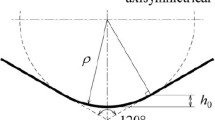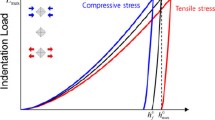Abstract
An optical Transparent Indenter Measurement (TIM) method was developed for measurement of material surface mechanical properties. During the spherical indentation test, in-situ measurements of indentation-induced surface out-of-plane displacements were obtained using an integrated phase-shifting Twyman-Green interferometer. Based on elastic recovery theory and 2D finite element analyses, a procedure was developed to determine the material Young's modulus using the measured surface out-of-plane displacements. During the spherical indentation test, contact radii were also measured and used to estimate the material post-yielding true stress-strain curve using Tabor's empirical relation. An experimental TIM apparatus was assembled to test on two engineering alloys and the results showed good agreement with known material properties.
Similar content being viewed by others
References
Tabor D (1951) The Hardness of Metals. Clarendon Press, Oxford.
Sneddon IN (1965) The relation between load and penetration in the axisymmetric Boussinesq problem for a punch of arbitrary profile. Int J Eng Sci 3:47–57.
Bulychev SI, Alekhin VP, Shorshorov MKh, Ternovskii AP, Shnyrev GD (1975) Determining Young's modulus from the indentor penetration diagram. Ind Lab 41(9):1409–1412.
Loubet JL, Georges JM, Marchesini JM, Meille G (1984) Vicker's indentation curves of magnesium oxide (MgO). J Tribol 106(43).
Doerner MF, Nix WD (1986) A method for interpreting the data from depth-sensing indentation instruments. J Mater Res 1(4):601–609.
Oliver WC, Pharr GM (1992) An improved technique for determining hardness and elastic modulus using load and displacement sensing indentation experiments. J Mater Res 7(6):1564–1583.
Taljat B, Zacharia T (1998) New analytical procedure to determine stress-strain curve from spherical indentation data. Int J Solids Struct 35(33):4411–4426.
Bhattacharya AK, Nix WD (1988) Finite element simulation of indentation experiments. Int J Solids Struct 24(9):881–891.
Bhattacharya AK, Nix WD (1988) Analysis of elastic and plastic deformation associated with indentation testing of thin films on substrates. Int J Solids Struct 24(12):1287–1298.
Komvopoulos K (1988) Finite element analysis of a layered elastic solid in normal contact with a rigid surface. J Tribol 110:477–485.
Komvopoulos K (1989) Elastic-plastic finite element analysis of indented layered media. J Tribol 111:430–439.
Kral ER, Komvopoulos K, Bogy DB (1993) Elastic-plastic finite element analysis of repeated indentation of a half-space by a rigid sphere. J Appl Mech 60:829–841.
Kral ER, Komvopoulos K, Bogy DB (1995) Finite element analysis of repeated indentation of an elastic-plastic layered medium by a rigid sphere, part I: surface results. J Appl Mech 62:20–28.
Kral ER, Komvopoulos K, Bogy DB (1995) Finite element analysis of repeated indentation of an elastic-plastic layered medium by a rigid sphere, part II: subsurface results. J Appl Mech 62:29–42.
Prchlik L, Pisacka J, Sampath S (2003) Deformation and strain distribution in plasma sprayed nickel-aluminum coating loaded by a spherical indenter. Mater Sci Eng A 360:264–274.
Chen H, Lin Q, Chen J, Yu Z, Zhao Y (2001) On plastic zone around an indentation during stress determination by impact indentation method. Trans China Weld Inst 22(5).
Yu Z, Zhao Y, Chen H (2001) Impacted indentation method of measuring residue stress. J Shenyang Arch Civ Eng Univ 17(3).
Kral ER, Komvopoulos K (1996) Three-dimensional finite element analysis of surface deformation and stresses in an elastic-plastic layered medium subjected to indentation and sliding contact loading. J Appl Mech 63:365–375
Nadai A (1931) Plasticity: a mechanics of the plastic state of matter. McGraw-Hill book company, Inc.
Underwood JH (1973) Residual-stress measurement using surface displacements around an indentation. Exp Mech 13(9):373–380.
Szutkowska M (1999) Fracture toughness measurement of WC-Co hardmetals by indentation method. J Adv Mater 31(3).
Alcala J, Barone AC, Anglada M (2000) Source, Influence of plastic hardening on surface deformation modes around Vickers and spherical indents. Acta Mater 48(13):3451–3464.
Haggag FM (1989) Field Indentation Microprobe for Structural Integraity Evaluation, U.S. Patent No. 4,852,397.
Fischer-Cripps AC (2000) Introduction to contact mechanics. Springer.
Johnson KL (1985) Contact Mechanics. Cambridge University Press.
Cloud G (2003) Optical methods in Experimental Mechanics, part 8: Michelson Interferometry. Exp Tech 25(5).
Kang BS-J, Skeen J, Perry K, Hung YY (1997) Crack tip displacement measurements using automated phase shift moiré interferometry, 1997 SEM spring conference on experimental mechanics, pp 311–312, Bellevue, WA.
Special Metals Corporation, http://www.specialmetals.com.
Feng C (2005). Development of a Transparent Indenter Measurement System and Indentation Analysis for Material Mechanical Property Evaluation, Dissertation, West Virginia University.
Author information
Authors and Affiliations
Corresponding author
Rights and permissions
About this article
Cite this article
Feng, C., Kang, B.S. A Transparent Indenter Measurement Method for Mechanical Property Evaluation. Exp Mech 46, 91–103 (2006). https://doi.org/10.1007/s11340-006-5862-5
Received:
Accepted:
Published:
Issue Date:
DOI: https://doi.org/10.1007/s11340-006-5862-5




